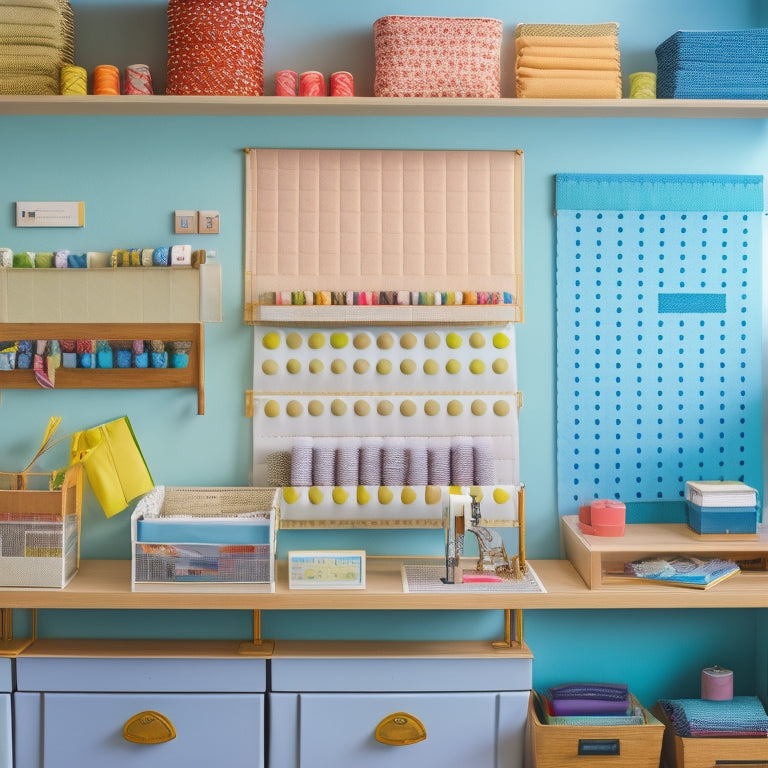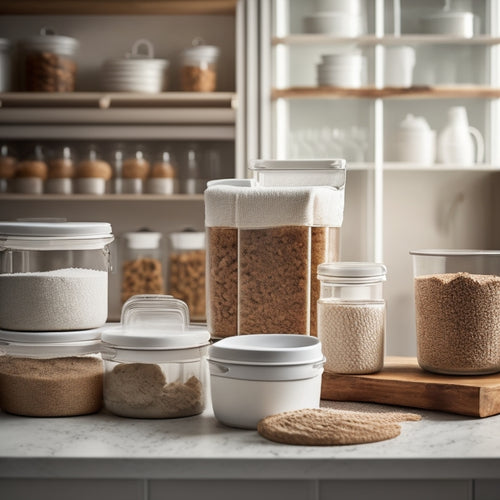
Efficient Sewing Pattern Storage Solutions Unveiled
Share
I've implemented upright envelope storage in boxes, categorizing and separating patterns for efficient retrieval. This system allows me to sort patterns by type and further separate them into distinct categories, making it effortless to locate specific patterns. I protect my patterns with clear plastic sleeves and label each one for quick identification. To maintain order, I regularly update and refine my storage system, employing preservation techniques and labeling strategies to prevent damage, loss, and disorganization. Now, I'm ready to reveal the fine details of my system, and the secrets to maximizing its potential.
Key Takeaways
• Utilize upright envelopes and storage boxes to efficiently organize and categorize sewing patterns for easy accessibility.
• Implement creative storage solutions like cardboard tubes and clear plastic sleeves to protect and label patterns.
• Maintain a digital catalog to ensure added protection and accessibility of sewing patterns, saving time and energy.
• Regularly update and refine storage systems to accommodate new patterns and prevent damage, loss, and disorganization.
• Employ labeling and categorizing strategies to secure easy retrieval and enhance the overall sewing experience.
Storage Methods for Sewing Patterns
Utilizing upright envelopes in storage boxes provides an efficient and organized way to store my sewing patterns, keeping them tidy and easily accessible. This creative storage solution allows me to categorize and separate my patterns, making it effortless to locate a specific one when needed.
I've also found that using cardboard tubes for lightweight and labeled storage is another effective DIY organization tip. Additionally, I reserve hangers for works in progress and slopers, ensuring that my sewing space remains clutter-free.
Organizing Patterns for Efficiency
I sort my sewing patterns by type, separating garments, accessories, and home decor patterns into distinct categories. This enables me to quickly locate a specific pattern when I need it.
This organized system allows me to efficiently find the pattern I'm looking for, saving me time and energy. I also utilize clear plastic sleeves to protect my patterns from damage, ensuring they remain in pristine condition.
Additionally, I label each pattern for quick identification, making it easy to retrieve the one I need. To take my organization to the next level, I maintain a digital catalog of my patterns, providing an added layer of protection and ease of access.
Preserving and Maintaining Order
To maintain my organized sewing pattern collection remains functional and efficient over time, I regularly update and refine my storage system to accommodate new patterns and reflect changes in my sewing priorities.
This involves implementing effective preservation techniques to guarantee the longevity of my patterns. I assess my storage needs, removing unused patterns and reorganizing my system to maintain order.
I also employ order maintenance strategies, such as labeling and categorizing my patterns, to secure easy access and retrieval. By doing so, I prevent pattern damage, loss, and disorganization, ultimately saving time and enhancing my sewing experience.
Through regular maintenance, I can confidently rely on my organized system to support my creative pursuits.
Frequently Asked Questions
Can I Store Sewing Patterns in a Basement or Attic?
"I avoid storing sewing patterns in basements or attics due to humidity control issues and pest protection concerns; instead, I opt for climate-controlled spaces with proper ventilation to preserve my pattern collection."
How Often Should I Clean and Dust My Pattern Storage Area?
I schedule regular cleanings to combat dust accumulation in my pattern storage area, ensuring a thorough dusting every 2-3 months and deep cleaning quarterly to maintain a pristine environment for my valuable sewing patterns.
Are There Any Pattern Storage Solutions for Small Sewing Spaces?
As I navigate my tiny sewing sanctuary, I seek order amidst the chaos. For small spaces, I opt for compact shelves and hanging organizers, maximizing vertical storage and keeping patterns within arm's reach.
Can I Use Acid-Free Tissue Paper for Long-Term Pattern Storage?
When selecting acid-free tissue paper for long-term pattern storage, I verify that the tissue quality is archival-grade to prevent degradation. If necessary, I choose paper alternatives such as museum-quality paper or polyester film for added durability.
Are There Any Eco-Friendly Sewing Pattern Storage Options Available?
I opt for eco-friendly sewing pattern storage options, utilizing recycled materials, sustainable fabric, and acid-free tissue paper to minimize environmental impact, ensuring my patterns remain preserved while aligning with my values.
Conclusion
In revamping my storage system, I discovered the Pareto principle holds true: 20% of my patterns generate 80% of my projects. By acknowledging this, I optimized my storage to prioritize frequently used patterns, freeing up space and time for creativity.
With a tailored system in place, I've increased productivity, reduced frustration, and protected my pattern collection. Efficient storage isn't just about organization; it's about amplifying creativity and making the most of my sewing time.
Related Posts
-

Best Stackable Containers for Flour Storage
When it comes to storing flour, you need stackable containers that prioritize freshness and organization. Look for ai...
-

Maximizing Kitchen Cabinet Storage With Smart Containers
You're ready to maximize your kitchen cabinet storage with smart containers! Start by choosing durable, versatile con...

